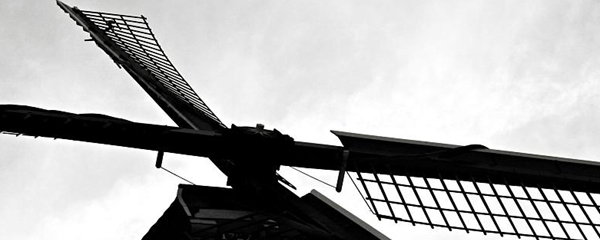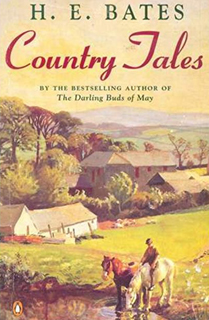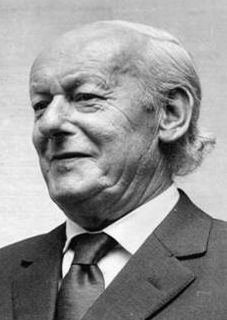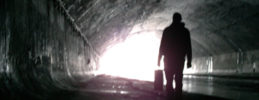
('Mill' © Barka Fabianova, 2007)
GRIST: THE MEN IN H.E. BATES’ ‘THE MILL’
by MIKE SMITH
‘The Mill’ is one of my favourite H.E. Bates stories. It’s one of the early stories, and appears in a 1938 collection, Country Tales. In the introduction to that collection, Bates said that it was ‘among the first half-dozen of my stories to date’. He was writing about a ‘transition’ that he believed he had made from writing by ‘the facile devil inside’, to a more objective and searching type of story. He included the tale in a later, catch-all compilation of the nineteen sixties, Seven by Five.
Alice, a young girl, exploited and uncared for by her parents, is farmed out to a local couple as a skivvy at the eponymous mill. There she passively endures, uncomprehending, the unwelcome attention of her employer to whom she falls pregnant.
With such stories it is easy to focus exclusively on what we might call ‘the victim,’ and on the outcome, but it’s worth also looking at members of the ‘supporting cast’ whose lives, behaviours and attitudes enable and create the events in which the protagonist is enmeshed. There are three men in this story: Jos Hartop (Alice’s father), Fred Holland (the miller), and Albert, Holland’s son, a soldier who returns on leave, and tells Alice, the central character, that she is pregnant. The story ends with a moment of realisation, about what has happened to her, not only at the mill, but implicitly – the moment takes place on her return home – over her whole life.
 At forty pages, it is a long short story, and is presented in eight numbered, variously sized segments. Of the relatively few characters in ‘The Mill’ only Alice herself is present throughout. The opening segment introduces her whole family. Jos Hartop is described as ‘a thin angular man, starved-faced.’ Alice and her mother are vividly painted as ‘…thin, with a screwed-up thinness that made them look both hard and frightened.’ In the confines of their groceries and rabbits van, Jos is ‘sprawling awkwardly’, his wife and daughter, ‘squeezed up’. The faces of all three ‘seemed moulded in a clay’ and are ‘a flat swede-colour.’
At forty pages, it is a long short story, and is presented in eight numbered, variously sized segments. Of the relatively few characters in ‘The Mill’ only Alice herself is present throughout. The opening segment introduces her whole family. Jos Hartop is described as ‘a thin angular man, starved-faced.’ Alice and her mother are vividly painted as ‘…thin, with a screwed-up thinness that made them look both hard and frightened.’ In the confines of their groceries and rabbits van, Jos is ‘sprawling awkwardly’, his wife and daughter, ‘squeezed up’. The faces of all three ‘seemed moulded in a clay’ and are ‘a flat swede-colour.’
Throughout this story Bates employs a heavy-handed imagery of suppression, repression, and compression. There’s a persistent intensity about the atmosphere in which these characters live their lives: dense, slow, and tightly bound. The story is claustrophobic with it. There are few scenes that are not inside a building, or that van, and Bates’ descriptions keep our eyes close on the characters.
Hartop drives ‘with vigilance and fear’. Alice’s arms are ‘ironed against her side’. Both women sit in ‘silent apprehension.’ Alice’s mother is quickly dismissed as being equally suppressed, and soon vanishes from the story. The van, in the opening sentence, is ‘old and repainted’ and its sign has ‘scratched’ lettering on ‘a flattened out biscuit tin nailed to the side.’ Hartop vents his anger on its failures, and on his wife and daughter. Hartop, believing he has heard something fall from the vehicle, orders Alice out to look for it, and then abandons her in the rain: “Go back a bit and see what it was…….We’ll stop at Duke’s Turn. You’ll catch up.”
Alice follows, driving rain seeming ‘to veer and smash her,…full in the face.’ And her reaction mirrors her reaction to her father’s uncaring, peremptory authority:
She walked without hurrying. She seemed to accept the journey as she accepted the rain and her father’s words.
Later, Bates gives us, again with heavy imagery, the mill itself and Mrs Holland, the warm, incapacitated wife whom Alice has come to help. The mill is as ragged as the van. Alice sees it first in almost the only sentences to give an open and distant view:
…across the flat and almost treeless meadows, she could see it clearly. It was a very white three-storied building, the whitewash dazzling, almost incandescent, against the wintry fields in the morning sunshine.
But closer up, ‘It was a chaos of derelict things.’ So too is the Holland’s marriage, for Mrs Holland is more or less confined to bed. Alice carries a dead fish into the mill: another piece of significant imagery, for she will cook fish for Fred every day.
Mrs Holland greets Alice and introduces her to the chaos inside the mill. All day, Alice works for her, and it is an interlude of what we might call normality in Alice’s life. For Alice, though, it is a revelation as Mrs Holland is funny, friendly, and supportive. She is grateful for what Alice does. Fred’s routines and needs are explained, and Alice begins to see beyond ‘her father’s ironic grousing and the feeling that she was a dead weight on his hands.’ Significantly, Mrs Holland exhorts the girl to ‘do all you can for him [Fred].’ Later, when Holland is repeatedly raping her, it is this instruction, and her accustomed subservience to her father that suppresses Alice’s resistance.
On meeting Fred Holland it is his voice that Alice is aware of first, but his appearance belies it: ‘Holland’s voice was very deep…’ But she sees that he is ‘a little man…’ who is ‘loose and careless and drooping…’
Bates goes to some trouble to differentiate Holland from Hartop. He is neither peremptory nor authoritative, not a bully nor a martinet, but ‘rather homely’ and significantly ‘essentially decent…/…tired, rather stunted and subservient.’ When he eats, Bates makes an observation that suggests we are looking at how a different half lives:
She had never seen anyone eat except like that, with the knife, low over the plate, greedily. Her father and mother ate like it and she ate like it herself.
This isn’t mere class prejudice. It is important to understand what normality is to Alice. She is reassured by the similarities: ‘…she felt a sense of reassurance, very near to comfort.’ He too is happy with her, ‘And in their room Holland was saying to his wife: “She seems like a good gal.”’
It’s important that we feel sorry for Holland rather than merely despise him. He is not the ignorant bully that Hartop is. The abuse visited by him on Alice is a descent for him, as well as an abuse of her. His inadequacies and his situation draw him into it. He is corrupted by his abuse of her. As we might expect from a writer of Bates’ stature, this is no simple villain exhibiting evil versus good. The story is as finely balanced as the author’s ‘The Little Farm’, where three characters play out a tragedy that is possible, inevitable even, only as a direct result of their individual weaknesses.
Holland, who rises early, must pass Alice’s room, and takes to knocking to wake her. One morning, hearing no reply, he opens her door. She is up, and he apologises, but the lure has been seen, the fish has risen.
In the moment taken to speak the words Holland saw the girl’s open nightgown, and then her breasts, more than ever like two lemons….
Though he steps away, the image haunts him.
…he kept seeing the mirage of Alice’s breasts in the candlelight.
The next morning, he enters Alice’s room while she sleeps. He shakes her but she sleeps on. Then he crosses the line.
…he put his hand on her chest and let it rest there. He could feel the breasts unexpectedly soft and alive, through the nightgown. He touched one and then the other.
She wakes, ending the fourth segment of the tale. In the fifth, Alice visits home, and Bates makes the point that she does not tell her parents what has happened. Sending her back, Hartop gives her a bruised orange:
“It’s tacked. It’s just a bit rotten on the side there.” He leaned out of the driver’s seat and pointed out the soft bluish rotten patch on the orange skin. “It’s all right. It ain’t gone much.”
It seems an appropriate remark at this point in the story.
 Back at the mill, Alice draws up her skirt and sits by the fire to warm herself. Holland comes in and the sight inflames him. Pretending to want to help her get warm he begins to massage, first her legs, but then her breasts. Over a page of writing as this assault progresses, Bates makes a number of significant points. A complex interplay of individual qualities enable the events to unfold the way they do. When Holland suggests that she undoes her dress, ‘to his astonishment’, she does, but she simply does not understand what is going on. His ‘bungling effort of tenderness’ is beyond her comprehension. ‘She stared at him abstractedly, not knowing the word [nellies], wondering what he meant.’ He makes ‘clumsy and agitated efforts to caress her.’ ‘She sat rigid, staring, not fully understanding.’ Throughout it all, ‘The motion hurt her’ and ‘Every time Holland squeezed her he hurt her.’
Back at the mill, Alice draws up her skirt and sits by the fire to warm herself. Holland comes in and the sight inflames him. Pretending to want to help her get warm he begins to massage, first her legs, but then her breasts. Over a page of writing as this assault progresses, Bates makes a number of significant points. A complex interplay of individual qualities enable the events to unfold the way they do. When Holland suggests that she undoes her dress, ‘to his astonishment’, she does, but she simply does not understand what is going on. His ‘bungling effort of tenderness’ is beyond her comprehension. ‘She stared at him abstractedly, not knowing the word [nellies], wondering what he meant.’ He makes ‘clumsy and agitated efforts to caress her.’ ‘She sat rigid, staring, not fully understanding.’ Throughout it all, ‘The motion hurt her’ and ‘Every time Holland squeezed her he hurt her.’
He tells her to lie down, and ‘for a moment she did not move. Then she remembered flatly, Mrs Holland’s injunction.’ It is perhaps at this sentence that your belief in the story will be tested. The injunction of course, was that one: to ‘do all you can for him.’ This, the story tells us, robs Alice of the will to resist.
The abuse continues. Holland’s speeches from now are predominantly exhortations to Alice: ‘Don’t you say nothing, Alice. Don’t you go and tell nobody.’ Eventually Alice realises that ‘They were words not of anger, not threatening, but of fear.’ She even goes so far as to tell him once, ‘I don’t want to, not to-night.’
Shortly after this, at the start of the seventh segment, Alice begins to show the signs of pregnancy, and Holland shows the first of anger. She tells him she is not well and ‘For the first time he went into a rage with her.’ Her mother and father visit, and notice she is ‘fillin’ out a bit.’ but they don’t put two and two together. Alice, though, does not even know there is two and two. Then Albert arrives.
An unexpected consequence of this is that Holland leaves her alone. His main concern now is to be not found out, threatening her ‘You say half a damn word and I’ll break your neck. See? I’ll smash you.’ This is the full measure of his fall from grace.
In the eighth segment Albert recognises Alice’s condition, but is more shocked to realise that she does not. She has absolutely no idea about pregnancy or how it comes about.
Prior to the revelation Albert has treated Alice well, taking her out and talking to her about her life. Their conversations fill out our understanding of her background, and broaden her view of the world, and of life in general.
Her eyes listened with the old absorbed unemotional look, but in reality with new feelings of wonder behind them.
This is all context for understanding fully her moment of epiphany at the end. Albert is the engine that opens those eyes to a wider world, one beyond the confines of the mill, and of the grocery van. Yet it is Albert who recognises that she is pregnant, and sends her back to Hartop. There is a moment, a page from the end, when, having explained the pregnancy to Alice, and having been told ‘He couldn’t marry me’, he senses something: ‘Albert saw that the situation had significance for him.’ Leaving, she feels ‘a sense of tenderness’ towards him.
Alice’s return home brings Hartop back into the story. As she walks into the kitchen he is eating breakfast: ‘…seeing her he paused with the bread half-way to his lips. She saw the fat dripping down to the plate again.’
Three men have brought her to this. Hartsop’s bullying. Holland’s weakness. Albert’s compassion. But it remains Alice’s story, and at the end she has reached a true realisation of herself, her feelings for Albert, and her pain:
It was only her eyes which registered the suddenness and depths of her emotions. They began to fill with tears. It was as though they had come to life at last.
~
 Mike Smith writes short fiction as Brindley Hallam Dennis, and poetry, plays and essays as himself! He lives on the edge of England and blogs at www.Bhdandme.wordpress.com
Mike Smith writes short fiction as Brindley Hallam Dennis, and poetry, plays and essays as himself! He lives on the edge of England and blogs at www.Bhdandme.wordpress.com


One thought on “Grist: The Men in H.E. Bates’ ‘The Mill’”
Comments are closed.